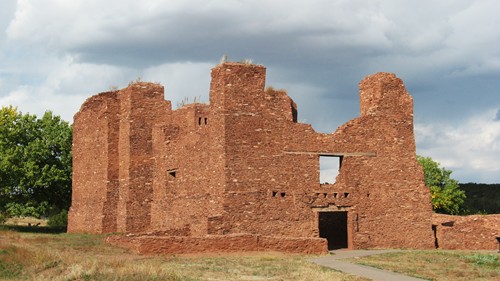Quarai
by wjw on October 19, 2010

On our way back from Fourth of July Canyon we stopped at the ruins of Quarai— or Cuarac, as it was known in its heydey. I’d never been there before.
Quarai was one of three large Indian pueblos standing on the trade route from the Rio Grande to the dry salt lakes southeast of the pueblos. (The others, which were larger, were Abo and Gran Quivira. I’ve visited them a couple times in the last several decades.)
The Spanish missionaries arrived in the 1620s and set about converting the Indians from their devil-worshiping ways. I don’t know how it went at Quarai, but I know how it went at Gran Quivira: a humble Franciscan monk arrived and asked for a place to stay, and petitioned for a room in which to perform worship. Three years later the Franciscan was running the place, punishing the Indians for devil worship and conscripting hundreds into building a huge fortress-like masonry mission church. The Indians had to hide their kivas (underground chambers used for religious ceremonies) inside the pueblo structure, which was actually pretty clever.
It seems to have gone a bit different at Quarai. Although the nearest underground kiva was filled in, it turns out there is a square kiva sunk right into the middle of the Spanish convento! So the padres must have approved of at least some of the traditional Indian ceremonies, and maybe observed them.
The only thing visible now at Quarai is the remains of the huge mission church and convento. The masonry pueblo itself, which was three stories tall, was excavated by archaeologists, but then filled in again to preserve the remains.
Back in the 1670s the missionaries were at perpetual war with the Spanish civil authorities, who soon realized that New Mexico would never pay for itself unless they were able to conscript Indian labor and foodstuffs. (The civil authorities also undermined the missionaries by allowing traditional ceremonies. The missionaries retaliated by setting the Inquisition on the Spaniards, accusing them of sympathizing with devil-worshipers!)
With all surplus food going to the Spanish, the Indians now had no surplus grain to trade with the Apaches, and so the Apaches began to raid the missions for food, slaves, and fun. For three years Quarai was unable to bring in a harvest due to Apache raids. Hundreds of people in the area starved to death. Eventually Quarai, Gran Quivira, and Abo were evacuated in the 1670s, and have in modern times been labeled “The Cities That Died of Fear.”
The descendants of the Quarai are now on the Isleta Reservation, just north of where I live, and are making up for four centuries of oppression by raiding the surrounding gambling population. In other words, they have a large and prosperous casino, sucking up the surplus wealth of the European invaders.